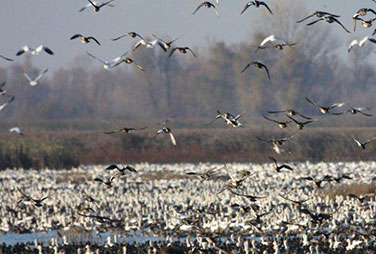Background
The California State Duck Stamp (Stamp Project) was created by legislation in 1971 (Fish and Game Code §3702). The stamp is required when hunting waterfowl and purchased by stamp collectors. All funds generated by the sale of stamps are deposited in the State Duck Stamp Account, administered by the California Department of Fish and Wildlife (Department). The funds can only be used for projects approved by the Fish and Game Commission (Commission) for the purpose of protecting, preserving, restoring, enhancing, and developing migratory waterfowl breeding and wintering habitat, evaluating habitat projects, and conducting waterfowl resource assessments and other waterfowl related research. These funds also may be used to reimburse nonprofit organizations for completed habitat projects.

During winter, wetlands and agricultural habitats in California, especially the Central Valley, support the largest single concentration of waterfowl (currently three to four million) in North America. This concentration represents more than 60 percent of all waterfowl wintering in the Pacific Flyway and more than 20 percent of all waterfowl wintering in North America. These birds are almost entirely dependent on water and habitat provided through human activities due to the significant loss of wetlands in California.
Since 1971, when adult hunters in California were first required to purchase a State Duck Stamp for waterfowl hunting, nearly $22 million has been spent to enhance wetland habitats. These funds, and additional contributions from non-profit conservation groups and federal agencies, have been used to enhance over 50,000 acres of wetland habitat in California on state and federal lands. An additional $5 million raised from the sale of State Duck Stamps has been expended to improve waterfowl habitat in the production areas in Canada that contribute waterfowl to the wintering populations in California.
Objectives
The goals of the Stamp Project, as described in legislation, are to protect, preserve, restore, enhance, and develop migratory waterfowl breeding and wintering habitat, evaluate habitat projects, and conduct waterfowl resource assessments and other waterfowl related research. To achieve these goals the Department has adopted the following four objectives:
- Identify activities which are needed for the conservation and maintenance of California's waterfowl habitat on public land.
- Develop and fund project-specific strategies to protect, enhance, maintain or restore significant waterfowl habitat on public land.
- Develop and fund project-specific strategies to conserve waterfowl populations.
- Develop, administer, and fund a grants program for waterfowl conservation.
Funding
The Stamp Project is funded by State Duck Stamp sales (Fish and Game Code § 3702). Before the Commission may consider any project proposal, the Department shall analyze such project and provide the Commission with recommendations as to the project's feasibility and need (Fish and Game Code § 3703). Two dollars and twenty-five cents ($2.25) of the amount collected by the Department for each state duck stamp sold shall be allocated by the Commission for the purposes of the North American Waterfowl Management Plan in those areas of Canada from which come substantial numbers of waterfowl migrating to, or through, California (Fish and Game Code § 3704). Lastly, this program requires a maximum of 6 percent overhead (Fish and Game Code § 3701). The Stamp Project has up to $1,135,000 that may be allocated for projects on a Fiscal Year (FY) basis.
Eligibility
To accomplish the objectives, the Department is authorized to award grants (and contracts where necessary) for waterfowl conservation purposes (acquisition, restoration, enhancement, creation and research) to nonprofit organizations, local government agencies, state departments and federal agencies (Fish and Game Code § 3702). The organizations must have the specific capacity (waterfowl habitat enhancement, restoration, creation and or research experience to deliver the objectives).
Examples of eligible projects include, but are not limited to:
- Enhance/restore/maintain wintering or nesting habitat for CA waterfowl species
- Restoring or creating brood ponds/summer water for CA waterfowl species
- Enhancing or restoring fall and spring use areas for CA waterfowl species
- Establishing islands and loafing bars
- Levee repair, replacement of water control structures, pump repair and installation
- Fence installation to control and/or manage livestock or wildlife and/or to enhance upland habitat for waterfowl nesting and goose forage
- Removal of nonnative invasive plant species and restoration (active or passive) of native and other desirable wetland or upland vegetation
- Research to obtain population parameters of species/subspecies/population
- Investigations of limited resources for specific species or subspecies such as eelgrass for Black brant
Application
The Stamp Project annually solicits proposals in November or December of each year based on approved needs, topics, and/or themes which address the goals and objective of the program through its Proposal Solicitation Notice (PSN). This PSN also contains the Stamp Project solicitation, submittal, and scoring procedures and a template (Word) for proposal submissions.
FY 2026 Proposal Solicitation Notice (PDF) released 11/25/2025 - Proposals due January 23, 2026, at 5:00 p.m.
Approved/Funded Projects